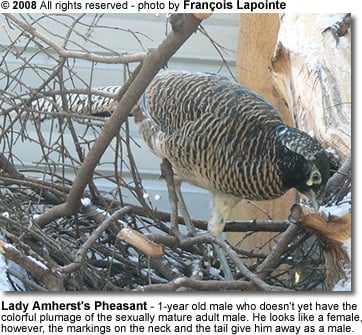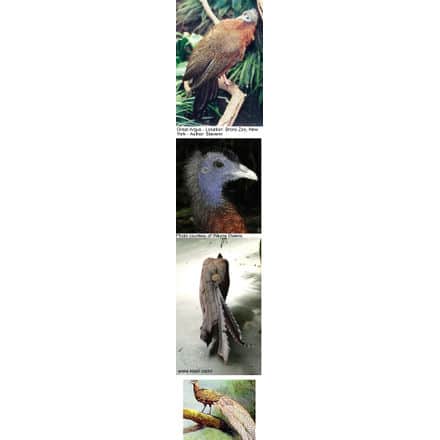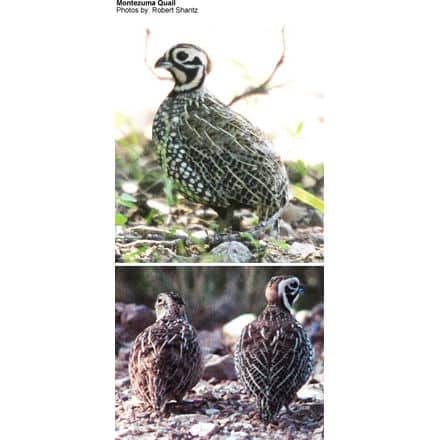Lady Amherst’s Pheasant aka “Ruffed” Pheasant
The Lady Amherst’s Pheasants (Chrysolophus amherstiae) are native to southwestern China and Tibet but have also established a self-supporting, but now declining, feral population in England.
This species is closely related to the Golden Pheasant (Chrysolophus pictus).
They usually roost in trees at night. Whilst they can fly, they prefer to run. The male pheasant has a gruff call in the breeding season.
Natural Diet:
They feed on the ground on grain, leaves, and invertebrates animals without internal skeletons, such as insects, larvae, earthworms, millipedes, snails, and spiders).
Description:
The adult male Lady Amherst’s Pheasants averages 43 inches (~110 cm) in length, its tail accounting for 31 inches (~80 cm) of the total length. It is unmistakable with its black and silver head, long grey tail and rump, and red, blue, white, and yellow body plumage. The “cape” can be raised in display.
The female (a hen) – featured below – is much less showy, with a duller mottled brown plumage all over, similar to that of the female Common Pheasant but with finer barring. She is very like the female Golden Pheasant but has a darker head and cleaner underparts than the hen of that species.
Keeping and Breeding the Lady Amherst’s Pheasant
Next to the Golden Pheasant, the Lady Amherst is said to be the easiest pheasant to breed. This pheasant is one of the most vibrant colored pheasant species.
Their ritualistic dance, display, and dazzling beauty make them a very popular species.
They can also be easily hand-tamed. The modest demands of the Lady Amherst make it an ideal species for the beginner to pheasant keeping.
These birds are very active and aviaries should be fairly large with plenty of branches and other objects for enrichment. They are docile and can be kept with other bird species such as doves, small hookbills, and finches.
Amherst pheasants should be kept separate from Golden pheasants to prevent cross-breeding. The Amherst will readily hybridize with the Golden Pheasant and the offspring are usually fertile. Unethical breeders will try to sell “hybrids” as new mutations as a way of “cashing in”– and you are well advised to ask for proper records and photos before purchasing such advertised “new mutations.” It is considered bad practice to breed hybrids as it causes damage to pure bloodlines.
- Visual clues that will help you to identify hybrids.
These pheasants may breed their first year, but it is better to use a fully colored male to not lose fertility. Their breeding season starts in May and they attain breeding age in their second year.
The hens average twenty eggs a season depending on the feed and care. The hen lays 6 to 12 creamy buff eggs, which she incubates for 23 to 24 days.
A monogamous species, it is best to keep the pair with their young from the previous year. Some males have helped in rearing young, but not all males make good parents.
The males can get aggressive with the females when caged, and having the other birds helps dilute this activity. It is also supposed to help to keep them in mixed aviaries, including doves, small hookbills, and finches. peafowl and eared pheasants in their aviary.
Captive Diet:
The Lady Amherst’s Pheasants diet is the same as in other pheasant species. A slightly higher protein breeder diet is recommended starting in January in addition to supplementation with greens and various grains. During the off-season, they are fed a lower protein pellet mixed with grain. mealworms, berries, and other fruits make nutritious treats.
Peanuts are often offered as treats — however, peanuts are often contaminated with aflatoxin, a fungal toxin. Aflatoxin is carcinogenic and causes liver damage in birds, other animals, and even humans. Roasting reduces aflatoxin but does not eliminate it.
North American peanut producers are currently working on eliminating contaminated peanuts from their products. Peanuts with dark spots on them should be considered suspect, but even those that look clean and perfect could be contaminated.
Below: Lady Amherst Hybrid (probably with Golden Pheasant)


Other Related Web Links: Pheasant General Information … Pheasant Species … Pheasant Taxonomy … Breeding Pheasants … Pheasant Photo Gallery … Housing Pheasants … Pheasant Diseases






